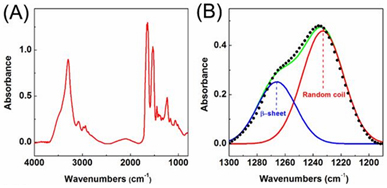Recently, Professor CHEN Xin’ s research group, a user of the National Center for Protein Science Shanghai(NCPSS), Institute of Biochemistry and Cell Biology, Shanghai Institutes for Biological Sciences, Chinese Academy of Sciences beamline stations from College of Materials, Fudan University, successfully prepared the tough protein–carbon nanotube hybrid fibers which can be comparable to natural spider silks. The relative achievements obtained by collaborated with several other institutes finally appeared on the Journal of Materials Chemistry B (J. Mater. Chem. B. 2015, 3: 3940) as the cover story.
Animal silks have been attracting a lot of attention in the biomedical field for their excellent mechanical properties and good biocompatibility. However, the figure-of-eight spinning behavior of silkworms is a major drawback in terms of the mechanical properties of silkworm cocoon silk as it introduces defects in the fibers. In Prof. CHEN’s previous researches, it has already been proved that silk fibroin fibers with controllable morphology and distinct structure could be produced by artificial spinning. Now Prof. CHEN’s research group has successfully prepared regenerated silk fibers by adding a small amount of carbon nanotubes by wet spinning process (Fig. 1). These hybrid fibers show a breaking stress of 0.42 GPa, breaking strain of 59%, and breaking energy of 186 MJ m-3, which is comparable to spider dragline silks.

Fig.1 Spinning of the RSF–CNT hybrid fiber
The infrared beamline of the NCPSS located in the Shanghai Synchrotron Radiation Facility has obvious advantages in characterization of small samples such as the hybrid fibers. The Synchrotron radiation FTIR spectrum of the single fiber has high signal to noise ratio(SNR) and good resolution to amide I (1700-1600 cm-1), amide II (1600-1500 cm-1) and amide III (1300-1200 cm-1) (Fig.2). Prof. CHEN’s research group also obtains the β-sheet content of silk fibroin from the deconvolution of the amide III according to the high-quality FTIR spectrum. The results show that the β-sheet contents increase with the draw ratio in wet-spinning process, and are obviously higher than that in the natural silkworm cocoon silk. All the results satisfactorily explain the toughening mechanism.

Fig.2 (A) Synchrotron radiation FTIR spectrum (B) Deconvolution of the corresponding amide III band. The sci-tech personnel of infrared beamline station (BL01B1) took an active part in Prof. CHEN’s experiments by providing strong technical support, making active contribution to the findings. This IR beamline station is the only one that based on the 3rd generation synchrotron light source in mainland China which has received nearly 2,000 hours applications from domestic scientific research units since its opening.
( Images provided by Prof. CHEN Xin’s research group, a user of the NCPSS beamline stations)
 Appendix:
Appendix: